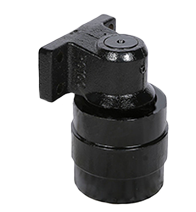What is excavator recoil spring?
The recoil springs serve as shock absorbers to protect the track and idler system from impact, excessive weight, and premature wear in order to extend the life of the undercarriage.
What is the function of the recoil spring on an undercarriage?
The recoil springs are the shock absorbers that protect the undercarriage from impacts and overload. The recoil springs prevent premature wear and extends the life of the track and idler systems.
What is the function of idler in undercarriage?
The idler wheels are a fundamental component of the undercarriage. As well as transferring some of the track frame loads into the tracks, their key function is to feed the tension from the adjuster into the tracks. Failure will: Reduce the excavator's stability.
How To Maintaining Your Track Spring Assembly:
Keep a Clean Undercarriage
Nobody’s favorite part of the job on a construction site is cleaning the machines and the undercarriage can seem like it should always have a good coat of dirt on it, but routinely cleaning the undercarriage and making sure the track spring assembly isn’t full of dirt or important parts aren’t hidden under a layer of grease helps to keep parts working properly and makes signs of trouble brewing simpler to spot.
Routinely Inspect Your Track Spring
If you’re a frequent reader of this blog, you know when it comes to maintenance we’re fully behind an ‘always watching’ approach. For your track springs an extra level of close inspection is important and can be done fairly quickly.
First, look at the recoil springs and make sure they aren’t broken, warped, or cracked. A sudden break in a recoil spring can be dangerous as they are under pressure and even though your machine might seem like it's working fine with a broken spring, it's actually lost an important safety component for other parts.
Next, inspect grease valves and seals. If grease is leaking out of the cylinder it's a clear sign the seal is failing and though the failure might seem small at first it can lead to a larger loss of tension and sudden and dangerous troubles in your track.
Match Your Track Tension to Your Working Environment
One of the benefits of tracked machines is their adaptability to a wide range of working and ground conditions and environments. The stability of tracks in loose materials, wet conditions, and rough ground is unmatched, but tracks work best when the tension is set to match the environment in which they are working. Even cold environments or ground prone to load the tracks with mud can change how the tension of tracks should be set. And simply keeping the tracks at proper tensions will keep your track spring assembly in good working order and extend the life of your tracks.
Test Your Track Tensioner
In the previous tip we suggested frequently adjusting your track tension to match your environment, but maybe your machine works day after day in the same site and nothing much changes that would need track adjustments. If that’s the case, you should still periodically use your track tensioner to tighten and then loosen your track. Routine use will allow you to be sure nothing has seized, watch to make sure movements are smooth and fluid and your piston isn’t stuck or bent, and ensure your grease valves take grease.
Every excavator will need to have its track adjusted sometime and routinely ensuring your track spring assembly works properly at all times is a simple way of making sure when that day comes it's up to the job.
Run Your Machine Like the Pro You Are
You’re reading an article on track spring assembly maintenance tips -- it’s probably safe to assume you’re the kind of operator who treats their machine right. For the sake of repetition though, it’s always important to remember that how you run your machine will affect the life of parts and how they function. There’s always a fine line between getting the most out of your machine and throwing all caution to the wind, but finding that line is a sign of an expert operator.
Ensuring you avoid overly repetitive movements, stay away from too much reverse action, and avoid running your machine when the tracks are too loose or tight are the basics of maintenance for your track spring assembly and your entire undercarriage.

Sign up to our newsletter for the construction machinery